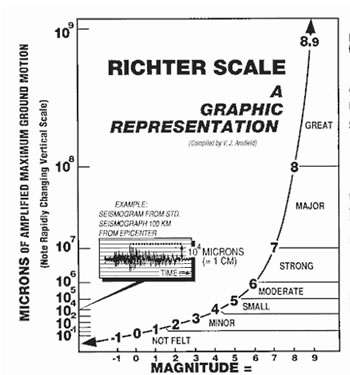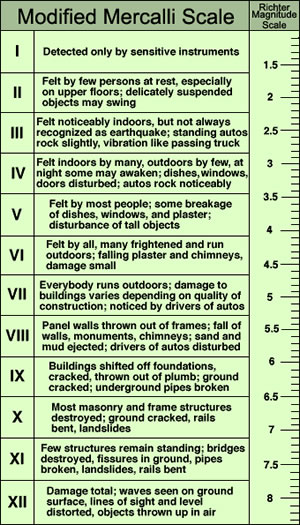Richter Scale vs Mercalli Scale
Key difference: The Richter magnitude scale is a scale that assigns earthquakes a number between 1 and 10 in order of increasing intensity. The Mercalli intensity scale is another seismic scale. It labels an earthquake from I to XII depending on the effects of the earthquake.
 Earthquakes are one of the most dangerous disasters that humans have to face. However, most earthquakes are actually not even noticeable. There are in fact millions of earthquakes that occur in a year. Of those, only 1.3 million are even noticeable by humans, at least according to the U.S. Geological Survey. Most of these actually occur in remote areas far from people and are often so low in intensity that most people would not notice.
Earthquakes are one of the most dangerous disasters that humans have to face. However, most earthquakes are actually not even noticeable. There are in fact millions of earthquakes that occur in a year. Of those, only 1.3 million are even noticeable by humans, at least according to the U.S. Geological Survey. Most of these actually occur in remote areas far from people and are often so low in intensity that most people would not notice.
There are many reasons why earthquakes occur. They range from meteor impacts and volcanic eruptions, to man-made events like mine collapses and underground nuclear tests. However, the most common reason for earthquakes are the shifting of the Earth’s tectonic plates.
As earthquakes can be quite devastating, humans needed to find a way to learn when and where earthquakes would occur. In order to do this, the seismograph was developed. A seismograph is any instrument that measures the motions of the ground, including those of seismic waves generated by earthquakes, volcanic eruptions, and other seismic sources. The records of the seismic waves helps seismologists to map the interior of the Earth, and to locate and measure the different sources of earthquakes.
Now, that the scientists know when and where the earthquakes would occur, they next needed a way to classify the earthquakes in order of how dangerous they were. Hence, the concept of a scale developed which would assign a number or category to the earthquake depending on its intensity. The Richter Scale and Mercalli Scale are two such scales.
The Richter magnitude scale is a scale that assigns earthquakes a number between 1 and 10 in order of increasing intensity. The scale was developed in 1935 by Charles Francis Richter in partnership with Beno Gutenberg. They both hailed from the California Institute of Technology. The scale was originally was to be used to only in a particular study area in California, and on seismograms recorded on only the Wood-Anderson torsion seismograph. However, eventually the scale was developed into a worldwide accepted standard.
 The Richter scale assigns the number on the basis of how much energy is released during the earthquake. The scale is a base-10 logarithmic scale, which means that an earthquake that measures 5.0 on the Richter scale has a shaking amplitude 10 times larger than one that measures 4.0, and corresponds to a 31.6 times larger release of energy. While the scale is usually considered to label from 1 to 10, and 0 being the basis to which the energy is being compared, the truth is that the scale does not actually have a lower limit. Many sensitive modern seismographs now routinely record quakes with negative magnitudes.
The Richter scale assigns the number on the basis of how much energy is released during the earthquake. The scale is a base-10 logarithmic scale, which means that an earthquake that measures 5.0 on the Richter scale has a shaking amplitude 10 times larger than one that measures 4.0, and corresponds to a 31.6 times larger release of energy. While the scale is usually considered to label from 1 to 10, and 0 being the basis to which the energy is being compared, the truth is that the scale does not actually have a lower limit. Many sensitive modern seismographs now routinely record quakes with negative magnitudes.
The Mercalli intensity scale is another seismic scale. It labels an earthquake from I to XII depending on the effects of the earthquake. It differs from the Richter scale, as the Richter scale measures the amount of energy that is released during an earthquake, whereas the Mercalli scale measures the amount of damage that the earthquake is capable of. The Mercalli scale “quantifies the effects of an earthquake on the Earth's surface, humans, objects of nature, and man-made structures on a scale from I (not felt) to XII (total destruction).”
The Mercalli intensity scale was originally revised from the simple ten-degree Rossi-Forel scale by Italian volcanologist, Giuseppe Mercalli in 1884 and 1906. In 1902, Italian physicist Adolfo Cancani expanded the Mercalli scale from ten degree to a twelve-degree classification. The German geophysicist August Heinrich Sieberg then completely re-wrote the scale and it became known as the Mercalli-Cancani-Sieberg (MCS) scale, which was modified and published in English by Harry O. Wood and Frank Neumann in 1931 as the Mercalli-Wood-Neumann (MWN) scale. The scale was then improved by Charles Richter, the father of the Richter magnitude scale. Today, the scale is known simply, and perhaps rightly, as Modified Mercalli scale (MM) or Modified Mercalli Intensity scale (MMI).
Classification of the Modified Mercalli Intensity Scale:
I - Instrumental
II - Weak
III - Slight
IV - Moderate
V - Rather Strong
VI - Strong
VII - Very Strong
VIII - Destructive
IX - Violent
X - Intense
XI - Extreme
XII - Catastrophic
Comparison between Richter Scale and Mercalli Scale:
|
|
Richter Scale |
Mercalli Scale |
|
Description |
The Richter scale was developed to assign a single number to quantify the energy that is released during an earthquake. |
The Mercalli Scale assigns a number to quantify the effects of an earthquake. |
|
Definition as per Dictionary.com |
A scale, ranging from 1 to 10, for indicating the intensity of an earthquake. |
A measure of earthquake intensity with 12 divisions ranging from I (felt by very few) to XII (total destruction). |
|
Alternate names |
Richter magnitude scale |
Modified Mercalli scale (MM) or Modified Mercalli Intensity scale (MMI). |
|
Developed in |
1935 |
1884 and 1906 |
|
Developed by |
Charles Francis Richter in partnership with Beno Gutenberg |
Giuseppe Mercalli |
Classification of Earthquakes as per the Richter Scale and Mercalli Scale:
|
Richter Magnitude Level |
Richter Category |
Effects |
Earthquakes per year |
Mercalli intensity |
Mercalli Category |
|
Less than 2.0 |
Micro |
Microearthquakes, not felt, or felt rarely by sensitive people. |
Several million per year |
I |
Instrumental |
|
2.0–2.9 |
Minor |
Felt slightly by some people. No damage to buildings. |
Over one million per year |
I to II |
Instrumental to Weak |
|
3.0–3.9 |
Minor |
Often felt by people, but very rarely causes damage. |
Over 100,000 per year |
II to IV |
Weak to Slight to Moderate |
|
4.0–4.9 |
Light |
Noticeable shaking of indoor objects and rattling noises. Felt by most people in the affected area. Slightly felt outside. Generally causes none to minimal damage. |
10,000 to 15,000 per year |
IV to VI |
Moderate to Rather Strong to Strong |
|
5.0–5.9 |
Moderate |
Can cause damage of varying severity to poorly constructed buildings. At most, none to slight damage to all other buildings. Felt by everyone. No Casualties. |
1,000 to 1,500 per year |
VI to VIII |
Strong to Very Strong to Destructive |
|
6.0–6.9 |
Strong |
Damage to a moderate number of well built structures in populated areas. Earthquake-resistant structures survive with slight to moderate damage. Poorly-designed structures receive moderate to severe damage. Felt up to hundreds of miles/kilometers from the epicenter. Death toll can range from none to 25,000, depending on location. |
100 to 150 per year |
VII to X |
Very Strong to Destructive to Violent to Intense |
|
7.0–7.9 |
Major |
Causes damage to most buildings, some to partially or completely collapse or receive severe damage. Well-designed structures are likely to receive damage. Can be felt up to 250 km away from epicenter. Death toll can range from none to 250,000, depending on location. |
10 to 20 per year |
VIII or greater |
Destructive, Violent, Intense, Extreme to Catastrophic |
|
8.0–8.9 |
Great |
Major damage to buildings, structures likely to be destroyed. Will cause moderate to heavy damage to sturdy or earthquake-resistant buildings. Damaging in large areas. Felt in extremely large regions. Death toll can ranges from 1,000 to 1 million. |
One per year |
VIII or greater |
Destructive, Violent, Intense, Extreme to Catastrophic |
|
9.0 and greater |
Great |
Near or at total destruction - severe damage or collapse to all buildings. Heavy damage and shaking extends to distant locations. Permanent changes in ground topography. Death toll usually over 50,000. |
One per 10 to 50 years |
VIII or greater |
Destructive, Violent, Intense, Extreme to Catastrophic |
Image Courtesy: alekwalker.blogspot.com, dnr.mo.gov









Comments
Emma Smith
Mon, 12/11/2017 - 22:26
Add new comment